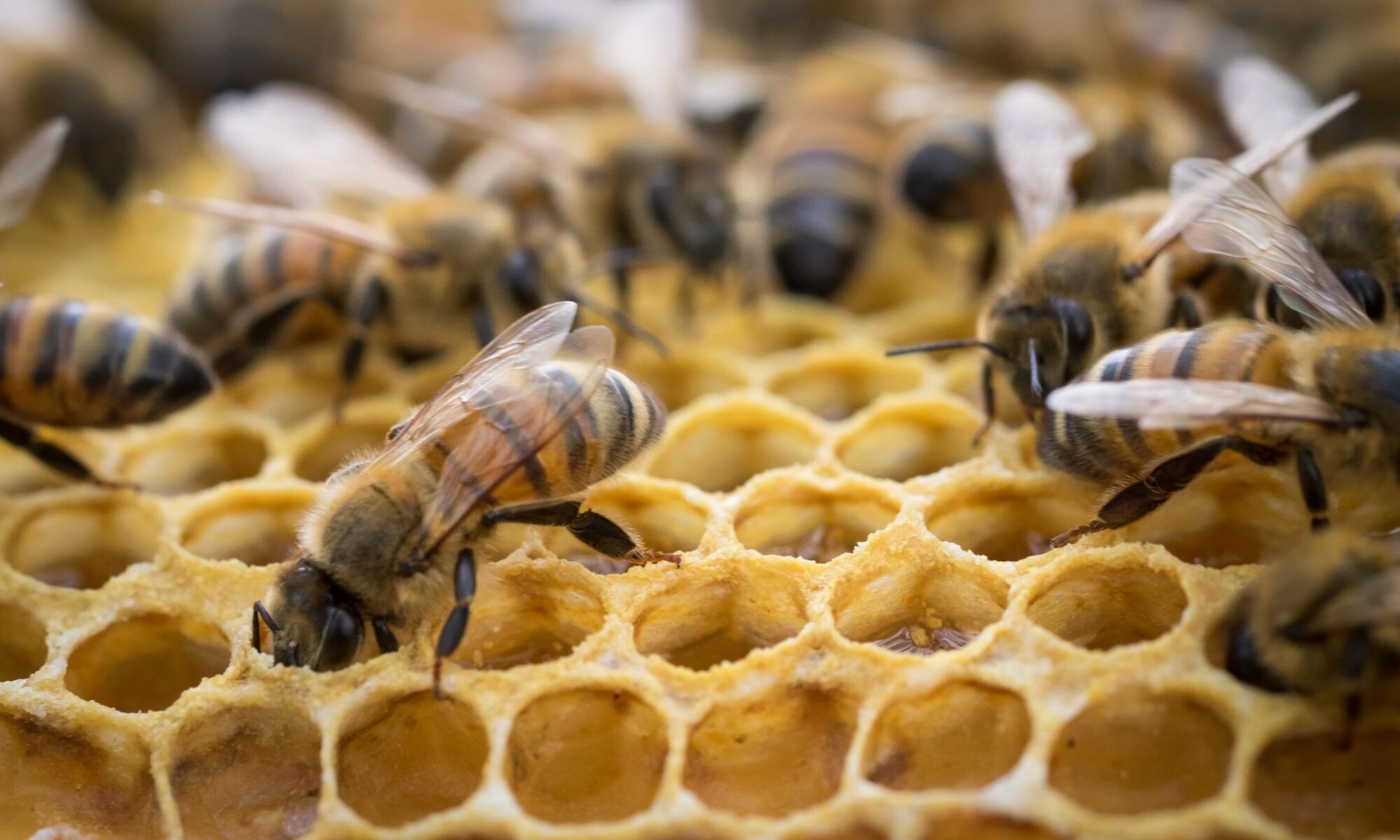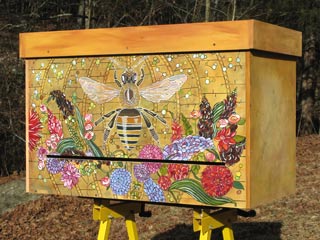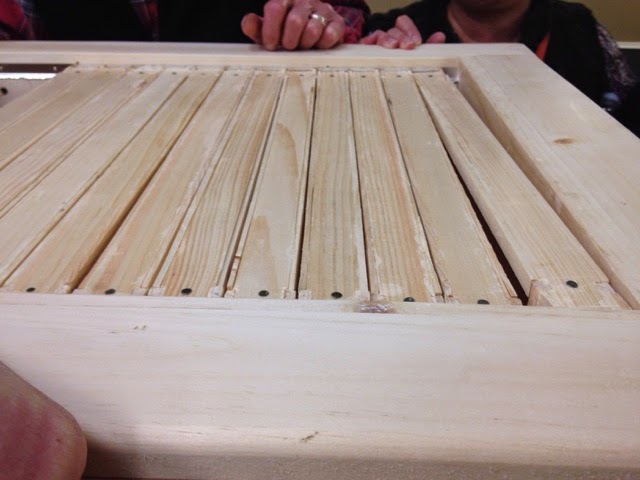This Article Comes From Notes of a Presentation By Fedor Lazutin 2013 (just before his death)
For Christmas 2013, David Liedlich mentioned that he gave his wife a copy of the book Keeping Bees with a Smile by Fedor Lazutin. The book, as you may have guessed from the author’s name, is by a Russian beekeeper who uses traditional horizontal Russian hives. Originally published in Russian in 2009, it was translated into English in 2013. After reading the book, Liedlich and his wife became fascinated by Lazutin’s ideas and traveled to the Ozarks to hear him give a presentation last fall. (Note: Although Lazutin speaks some English, the talk was in Russian, and translated by his editor, Leo Sharashkin.) The presentation Liedlich gave to our club is based on the talk he heard last year.
About Fedor Lazutin
Sadly, Lazutin passed away this past February from a brain tumor. However, prior to that, he and his wife, Lena, kept approximately 100 hives in the Kaluga region of Russia (approximately 150 miles outside of Moscow.) The conditions in this region are quite similar in terms of temperature and forage time to Zone 4 in the US (e.g., New Hampshire and Vermont).
Fedor began his beekeeping career with Caucasian bees in Dadant hives. However, he suffered so many losses that he decided there had to be a better way. As a result, he began researching historical beekeeping to see how things were done in the past. This led him to beekeeping in traditional Russian hives.
He says that he never uses any kind of treatments for diseases or pests. Rather, he relies on good forage away from farms that use pesticides, not feeding, and vigorous bees as well as his extra-deep hives for success.
The Bees
Lazutin’s book describes how, prior to the Soviet era, Russian beekeepers used European black bees. The European black bee is the native bee of much of northern Europe (England, Ireland, France, Poland, Germany, Russia, etc.). Over the years, it has been replaced by the huge infusion of southern races of bees. Places with wild European dark bees are much more rare these days. When we think of Russian bees, we primarily imagine the “Russian” bee from the Primorsky region, which is likely derived from Carniolan bees that were imported there long ago. The “Russian” bee from Primorsky is not a black bee or even a separate race of bee. It is simply a European bee that has been exposed to Varroa mites for much longer.
In any case, the black bees were known for being highly defensive, so when beekeeping became a government-regulated activity, gentle grey Caucasian bees were shipped to apiaries all over Russia. In fact, this is the bee that Lazutin started with as well. However, over time, Lazutin began to feel that the Caucasian bee is not as well adapted to the colder climates and shorter foraging seasons outside of the Caucasus. As a result, he switched to the native European black bee.
Lazutin’s spring starts around March, and his bees can build up from a population low of about 15,000 in spring to about 80,000 during the peak of his summer in late June/early July. The colony’s peak population corresponds with the maximum bloom for his area.
According to Lazutin, beekeepers should maintain and improve their local strains of bees. If one can’t obtain local stock, then he says bee keepers should improve what stock they have by installing swarms.
Historical Perspective on Hives
Observing hives in their natural environment can provide beekeepers with insight. However, local conditions should also be factored into the observations. For example, we know that bees live in hollows. However, the further south one goes (i.e., the warmer the climate), the less important a hollow is to the bees. For example, bees like Apis dorsata and Apis cerana make their nests directly on tree branches.
In the 19th century, books started making recommendations for hive size based on observation of feral hives. Hollows with a 10″ diameter were recommended. However, Lazutin purports that this conclusion was faulty. Observations were skewed by logging activities that had destroyed trees with larger hollows. In other words, bees were simply making the best of what was available. According to Lazutin, modern beekeepers are continuing to use hives that are too small based on erroneous centuries-old conclusions.
Horizontal hives vs. Vertical hives
It’s rare to find live tree hives, log hives, gum hives, or skeps anymore. For reasons related to convenience and practicality, these have been replaced by moveable frame hives. Commercial beekeepers that need to move hives around frequently will certainly want vertical hives. Horizontal hives with extra deep frames are extremely difficult, if not nearly impossible, to move, so they are well-suited for hobbyists and stationary apiaries.
A horizontal hive with 25 extra deep frames (each frame is the size of 2 Lang deeps) has the equivalent volume of 5 Lang deeps. The enormous volume of this hive reduces swarming and provides enough space to store all of the honey produced in a single season.
Horizontal hives with deep frames in various cultures
Horizontal hives are not a new invention. Records of them go back to the 1500’s, though they were comprised of bars on tubs. In the 1800’s, Georges de Layens designed a popular deep horizontal hive with movable frames. Variations of this design have been used in a number of European countries, including:
- Spain’s colmena Layens hive
- France’s ruche de Layens
- Trough hives in Sweden (tragupka) and Denmark (trugstade) (Note: traditional Danish hives are available for purchase from Swienty.)
- Poland
- Ukraine (Note: the Ukrainian hive is taller than wide. It holds 36 frames in 2 18-frame rows. Although it winters well and can be used with standard extractors, Lazutin says that it tends to encourage more swarms.
Constructing a horizontal hive with extra deep framesLazutin recommends building the hive with double walls. For the inner lining, he says solid wood is best, though plywood is adequate. An interesting sidenote is that L.L. Langstroth also recommended double-walled hives to provide insulation, but he correctly predicted that “Such is the passion of the American people for cheapness in the first cost of an article, even at the evident expense of dearness in the end, that many, I doubt not, will continue to lodge their bees in thin hives in spite of their conviction of the folly of doing…”
A layer of insulation should go between the inner and outer walls. Lazutin recommends 1 1/2″ to 2″ of foam polystyrene. He says 2″ is equivalent to 5″-6″ of wood. However one could also use natural materials like flax fiber mats.
The entrance, which is positioned about 14″-16″ down from the tops of the frames, should be 1/2″ high to allow bees to come and go without getting blocking the entrance. The entrance is nearly the entire length of the hive, but it can be reduced to whatever length is needed at the time.
A division board is used much like in a KTBH. However, rather than fitting snugly against the sides of the hive, Lazutin recommends that there be a gap at the bottom of the division board. This allows bees to travel the entire length of the hive and see how much available space they have.
One can use a flat roof, but Lazutin recommends an insulated peaked roof, particularly for snowy climates and a steel hive stand about 16″ high.
The hive uses extra deep frames that sit tightly together just like in a TBH. The frames are equal in depth to 2 Lang deeps. The frames can be built as a single frame (though it’s difficult & expensive to find an extractor that will accept the frames), or two deep frames can be bracketed together. Note, if using commercially available frames, which have a bit of space between them, a burlap cloth should be laid over the frames to close them off. A bit of extra space is left beneath the frames. Unlike with a TBH, Lazutin recommends using foundation, though he makes his own from treatment-free wax. However, he also recommends that the foundation size match the size that is natural for one’s particular strain of bee.
 |
| Interior view of Liedlich’s hive. Instead of using large frames, he’s bracketed two Langs together. Note: the bottom of the hive has not yet been added. |
Clustering in the hive
In his book, Lazutin discusses how a cluster moves upward at a pace of approximately 1 mm every 24 hours during the winter. After doing a bit of math, he concludes that the cluster needs a certain amount of space overhead in the frame so that it can move unhindered to new honey. (I can’t recall exactly, but I think it translates to a minimum of 16″ tall frames for his climate For other climates, the required number of inches will vary. For example, in France, where the Dadant hive was developed for a much shorter, warmer winter, 12″ is just enough, though it’s pushing it, too.)
Harvesting honey
Just as with a TBH, honey is harvested from the edges of the hive. One interesting note is that Lazutin recommends harvesting just once per year, about 3 weeks after the last brood has emerged in the fall. He says this makes harvesting easier because they are not as defensive. Also, the brood must must be out of their cells so that they can rearrange their stores as they see fit. Of course, not all honeys have the same nutritional/medicinal value to the bees. By taking only surplus honey from the edges of the nest after the stores have been rearranged, beekeepers ensure that they are leaving the bees what they need to stay healthy through winter.
Advantages of a horizontal hive with extra deep frames
For all you TBH beekeepers, these advantages are going to sound really familiar, but I’ll list them anyway.
- Minimal interference with the brood nest since it doesn’t get exposed during inspections. The brood nest is inspected and disturbed once in the spring in a Lazutin hive. The rest of the management through the year need not disturb the brood nest.
- Easy inspections since the brood nest remains largely undisturbed
- Easy to expand/decrease the hive size without disrupting the brood nest’s microclimate. This is in stark contrast to vertical hives, especially in cold climates where adding supers too early can chill brood or removing supers can cause swarming if done too late.
- Lazutin is very much against feeding sugar, so the colony prepares for winter on it’s own. It also overwinters without any human assistance.
- Honey is harvested at a time when the bees are beginning to cluster, so they are not as defensive.
- The colony can winter outdoors instead of in sheds, which is common in Lazutin’s climate.
- Easy to strengthen weak colonies by combining them with stronger ones. The long entrance allows bee keeper to create entrances where needed.
- The long entrance also allows for making easy splits.
- No heavy lifting of supers or brood chambers. (Note: 1 extra deep frame of honey can weigh up to 20 pounds.)
- Bees consume less honey in winter in an insulated hive because they aren’t working as hard to stay warm.
Disadvantages of a horizontal hive with extra deep frames
- One has to either modify an extractor to take the extra deep frames. Or if one is using two frames bracketed together, they have to be separated before inserting them into an extractor.
- Difficult to move the hive. Virtually impossible to move in the summer when full of honey. Even an empty hive requires more than one person to move it.
Tweaking the hive
- Since writing his book, Lazutin has stopped making a raised screened-off chamber under the frames.
- He also doesn’t leave screened bottoms open during the winter because the bees were using more honey.
Lazutin’s ObservationsWhen inspecting, Lazutin insists that disturbances be kept at a minimum. Bee keepers should look for brood and not queens. He believes that constant disturbances lead to more swarming. He also says his hives rarely swarm. He credits this to the hive’s large volume and to his practice of removing surplus honey and old comb from the brood nest. His queens stay productive 2-3 years, and he actually has to induce swarming.
He hives primary and secondary swarms individually, but weak afterswarms are combined. Feeding weak swarms seems to be his one exception when it comes to feeding. Initially, he didn’t feed them either, but in the end, he relented. He felt that he was losing a lot of perfectly good bees who would have survived and done well if they’d had just a little boost in the beginning.
He’s also had good results by combining weak swarms with weak, older colonies. If he has a shortage of swarms, he’ll also fix a weak colony with queen cells from a colony preparing to swarm.
Wintering and moisture controlLazutin recommends a couple of options for wintering. One method uses a special frame containing 10 lbs of silica gel dessicant placed behind the divider. No top vents are used.
Liedlich plans to experiment with a 5″ thick peat moss pillow on top of the frames under vents — very much like a super filled with wood shavings above a Langstroth hive in winter (or like the quilt in a Warre). He indicates that he is trying to mimic an approach that is used in the attics of houses — vents in the attic with insulation on the attic floor.
More Info
I took a number of notes on Lazutin’s beekeeping year. However, I’ll never finish this post if I don’t stop somewhere. Maybe, if I get enough interest in the comments, I’ll write up a Part 2. In any case, I highly recommend reading his book, which has detailed notes on his yearly maintenance activities. If you’re unsure whether you want it, you can check out the contents of the book and see some sample pages online. One last thing I wanted to mention — you can get plans for a Russian horizontal hive on Sharashkin’s site, Horizontal Hives. The plans have lots of measurements and photos, so they look pretty easy to follow.
If you happen to speak Russian, Lazutin also has a number of talks on YouTube. I minored in Russian and even lived in Moscow for about 6 months, but I’ve forgotten way too much. This may give me the motivation to brush up on old skills so that I can listen in. 🙂



.svg/800px-Map_of_Russia_-_Kaluga_Oblast_(2008-03).svg.png)

